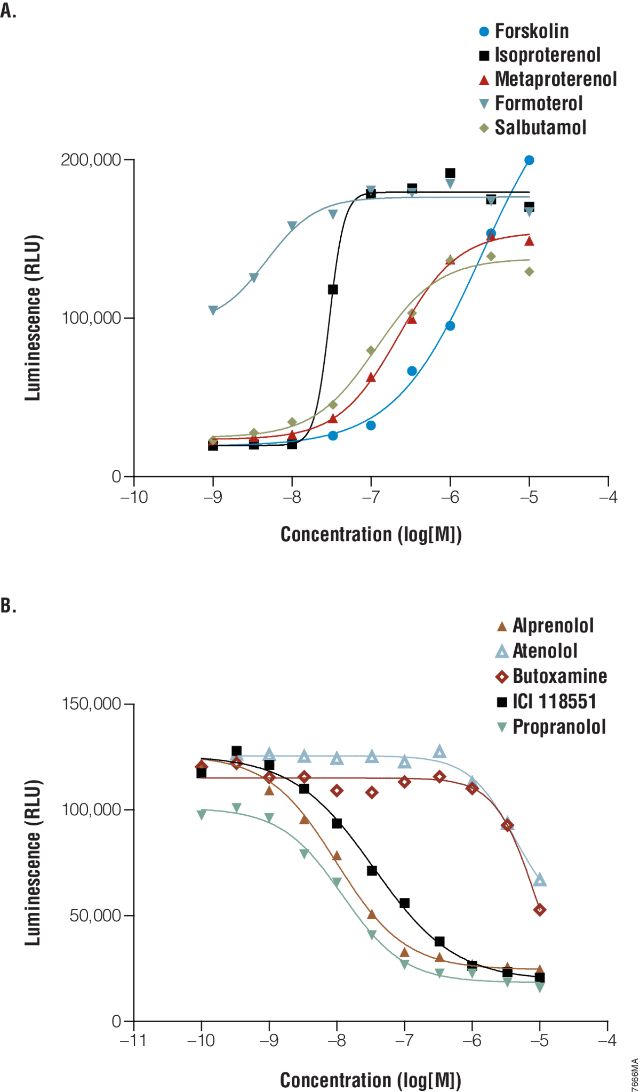GloSensor™ cAMP HEK293 Cell Line 2 vials E1261
pGloSensor™-22F cAMP Plasmid 20μg E2301
pGloSensor™-20F cAMP Plasmid 20μg E1171
GloSensor™ cAMP Reagent 25mg E1290
GloSensor™ cAMP Reagent 250mg E1291
将目的受体和该生物传感器在选定的细胞系中进行瞬时表达时,研究者可使用GloSensor™ cAMP 检测试剂盒进行检测。此外,还可以创造出同时被生物传感器和目的受体基因转染的稳定细胞系。操作过程很简单:用GloSensor™ cAMP Reagent (GloSensor™ cAMP试剂) 预平衡细胞大约2 小时;然后用特定的激动剂/ 拮抗剂或者未知活性的化合物处理细胞,10-30 分钟后检测发光。无需其它加样步骤或者操作过程。大部分带有自动进样器的常用发光检测仪都能检测,比如GloMax® 系列发光检测仪。GloSensor™ cAMP 试剂要求在GloSensor™ Limited Use Label License (GloSensor™ 有限使用标签许可证书) 指导下使用。
选择合适的质粒:
我们提供了生物传感器的两种变体。在多数实验中,我们建议首选 pGloSensor™ -22F cAMP 质粒。
pGloSensor™ -22F cAMP 质粒:与pGloSensor™ -20F cAMP质粒相比,用该质粒进行体外无细胞表达得到的生物传感器,在cAMP 饱和时活化EC50 及信噪比得到增强。而在活细胞中,这两种质粒表现出的性能基本类似。
pGloSensor™-20F cAMP 质粒:该质粒编码的生物传感器可在37℃下的HEK293 细胞中表现出良好的性能;而pGloSensor™ -22F cAMP 质粒所发出的萤光在生理温度下更难检测。
关于这两种质粒基本性能差异的更深入解释,请参阅Technical Manual (#TM076) 的第3.B 节——GloSensor™ 质粒的选择建议。
特点 - 优点
• 同类产品中性能最佳:高Z` 值及高信号;背景比值非常适用于HTS/uHTS;高达1,000 倍的光输出变化。
• 无需裂解的活细胞检测模式:“0 步骤检测”极大地方便了HTS/uHTS;对活细胞内的cAMP 的方便监测为受体生物学提供了更为完整的分析手段。
• 高灵敏度及增加的生物相关性:方便检测低丰度内源受体;直接检测Gi- 偶联受体的活性及在未加入毛喉萜(forskolin) 时反相激动剂的活性。无需加入PDE 抑制剂。
应用
注意事项
有关包含GloSensor™技术在内的用户实验拓展服务请联系 Promega。

Figure 1. Overview of the GloSensor™ cAMP Assay protocol.
Cells are pre-equilibrated with GloSensor™ Reagent for approximately two hours and then treated with specific agonists/antagonists or library of compounds, and luminescence is measured after 15–30 minutes.

Figure 2. Interrogation of G-alpha-s-coupled receptors using the GloSensor™ cAMP Assay.
The GloSensor™ cAMP HEK293 Cell Line was treated with varying concentrations of agonists or antagonists of the endogenous beta2-adrenergic receptor. Panel A. Cells treated with agonists.Panel B. Cells treated with antagonists in the presence of 1µM metaproterenol agonist. Experiments were performed as described in Section 5 of Technical Manual #TM076.

Figure 3. pGloSensor™-22F cAMP Plasmid.